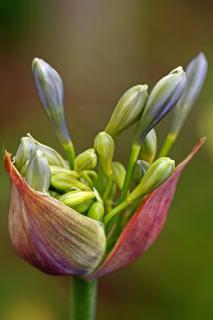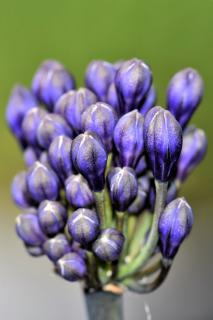

Lily of the Nile, with latin name Agapanthus, is a marvelous perennial that blooms from spring to summer, producing magnificent floral scapes.
Lily of the Nile key facts
Name – Agapanthus
Family – Liliaceae (lily family)
Type – perennial
Height – 24 to 40 inches (0.6 to 1 m)
Exposure – full sun
Soil – ordinary, well drained
Flowering – June to September
This is a plant that you must absolutely have if the climate is mild enough.
However, if summer is the time for majestic blooms, winter requires specific care and attention…
For regions with rather cool winters, plant your lily of the Nile in spring, for them to harden before the first winter.
Elsewhere, for mild-wintered climates, lily of the Nile can be planted in fall.
If you have purchased your Agapanthus in pots, you can plant them all year round, except during frost and heat spells.
If you live in a region where winter freezes a lot, grow your plants in in pots to be able to protect your Lily of the Nile from freezing cold.
Lily of the Nile rhizomes must not be planted in too deep a hole.
 The easiest and most common technique to propagate Lilies of the Nile is rhizome division in spring.
The easiest and most common technique to propagate Lilies of the Nile is rhizome division in spring.
Indeed, the vegetation phase is when you will get the highest propagation success rates for Agapanthus.
It is also possible to propagate Lily of the Nile through seed but this technique is slower and more challenging.
When you notice wilted flowers, cut the floral scapes as short as possible to avoid needlessly draining the plant.
Lily of the Nile are plants that cannot survive harsh colds, and so must be grown in areas where winter is mild.
If winter is mild, leave your plant in place without removing its leaves.
If your lily of the Nile are grown in pots, it is best to bring them indoors, in a cool, well-lit room where it never freezes.
If your plants are directly in the ground, you must cut the leaves before the first frost spells and cover the stump with thick mulch. You can use dried leaves, for example, or any other mulch.
 This beautiful perennial produces long stems donning magnificent blue flowers that are around 6 to 8 inches (15 to 20 cm) across.
This beautiful perennial produces long stems donning magnificent blue flowers that are around 6 to 8 inches (15 to 20 cm) across.
This magnificent floral scape can reach over 3 feet (1 meter) long.
In the backdrop of flower beds is where they will best be noticed, but they will be very appealing in pots or garden boxes on a terrace.
You can also create beautiful Lily of the Nile beds with only that flower throughout the bed, in the center of your garden or along a walkway.
They need heat and sun to produce beautiful flowers.
There are several species and varieties within the Agapanthus genus, which differ in the white or blue colors of their flowers. One lily of the Nile variety that is hardier than the rest is the ‘Blue triumphator’.
Here are some interesting Lily of the Nile varieties that we have selected for you:
To enhance blooming, add granulated organic fertilizer in spring!
I have a flower that was probably planted close to a hundred years ago in my yard that my plant identifier says is agapanthus but is totally hardy (I,m zone 6 in NY) and is light pink I thought it was an amaryllis but it is hardy
Planting lilies is one of the most interesting jobs, for me this is the most beautiful flower in the world.